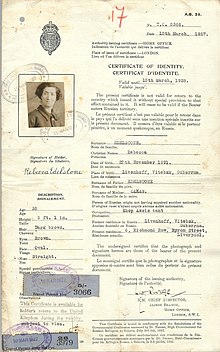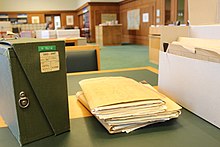Archives of the League of Nations
The archive of the League of Nations is a collection of historical and official files of the League of Nations . This collection is kept at the United Nations Office in Geneva (UNOG), where it is administered by the Institutional Memory Department of the UNOG Library. The archive comprises around 15 million pages and 500,000 units of documentation. The files are almost three kilometers long. In 2009 the historical importance of the League of Nations Archives was recognized when it was included in the UNESCO World Document Heritage Register.
Historical background
During its entire existence (January 10, 1920 - April 18, 1946) the League of Nations created and stored documents. The archive spans the founding period, with the negotiations on the Treaty of Versailles in 1919 , up to the dissolution of the League of Nations in 1946. In general, the League of Nations kept the documents for work purposes (with no intention of preserving its past). As early as 1919, the secretariat of the League of Nations developed a registry system responsible for opening files and keeping administrative registers and official acts. These reflected the workings of the Council, the Assembly, and their affiliated committees, commissions and conferences.
In 1946 the newly founded United Nations took over the archives and filing of files of the League of Nations. At that time, these documents were not actually considered a historical archive and their access was extremely restricted. The archive was temporarily moved to United Nations Headquarters in the United States to help set up the new administration. This chapter of history is generally little known, but shows a) the value of this archive; b) that the history of the League of Nations cannot be reduced to its setbacks. It was not until 1956, during a restructuring by the UNOG library, that the archive was separated from the UN administration. However, their access remained very limited and researchers were only granted a very strict “merit system”.
In 1965 the Carnegie Endowment for International Peace offered to finance a project that would make the League of Nations documents accessible to researchers. The project began in 1966 and ended in 1969. The most important result was the creation of a primary search aid for the archive, the “ Repertoire général ” (accessible via external links), which marked the transformation of the files and League of Nations documents into a real archive. In addition, access to the archives was defined and determined by official rules in a two-page document entitled "Access to the Archives of the League of Nations", which was published in 1969 by a circular from the Secretary General.
structure

The Archives of the League of Nations is a historical collection of the Archives of the United Nations in Geneva, organized according to the administrative departments that existed at the time of the League of Nations. An example is the Mandate Department , which deals with the administration of the areas of the Mandate system created by the Versailles Treaty.
The archive is divided into two groups: the secretariat archive and the external funds. The Nansen Fund (also known as the " Mixed Refugee Archive Group ") is the only fund that is viewed as a hybrid.
The Secretariat's archives group
The Secretariat's archives group includes documents that have been drawn up or received at the headquarters of the League of Nations in Geneva. It consists of files from the registry system and files from certain departments of the League of Nations. These files are referred to as registry files or department files.
The registry system
The registry system was a centralized part of the secretariat, which indexed and processed most of the files of the League of Nations according to official rules. The files of the registry system are divided into three different chronological periods: 1919-1927, 1928-1932 and 1933-1946.
Department files
Department files were created and generated independently and voluntarily by specific departments (e.g. the economic and financial sector, the mandate section, etc.). Consequently, they are not really part of "official history". Because they were outside the registry system, department files were sorted according to the procedures of their respective departments. As a result, they are less well organized than the archives of the registry system.
External archive funds
The external archive funds are archive groups that have been collected outside the secretariat. They have been compiled and controlled by the specific institutions that created them. Examples of this are the archives of the Government Commission of the Saar Basin and those of the Office of the League of Nations in Berlin.
Collections
In addition to the two main groups, the League of Nations archive also includes "collections", which are documents that have been compiled independently of the administration of the League of Nations. The main group of this type is known as the "Document Collection" of the League of Nations.
Destroyed or lost archives
Parts of the League of Nations archives were destroyed at different times for various reasons. For example, department files were not necessarily subject to the rules of the registry system, which often led to the destruction of documents for administrative reasons. Sometimes war events also led to destruction. The most serious losses suffered later departmental files and files of the first two general secretaries. Many external funds have been lost due to war damage and / or systematic destruction. The exact number of missing archives is not yet known.
Project for full digital access to the League of Nations archive (LONTAD)
The UNOG Library (now the UN Library and Archive Geneva) started the project for full digital access to the League of Nations Archives (LONTAD) in 2017 with the aim of preserving and digitizing the Archives of the League of Nations and making it accessible through an online portal. The basic aim is to modernize access to the archive for researchers, educational institutions and the general public.
Web links
Individual evidence
- ↑ Where global solutions are shaped for you | Library & Archives | Mandate of the Institutional Memory Section. Retrieved July 2, 2020 .
- ↑ a b c Where global solutions are shaped for you | Library & Archives | Digitization programs. Retrieved July 3, 2020 .
- ↑ https://plus.google.com/+UNESCO : Memory of the World Register. March 29, 2017, accessed July 3, 2020 .
- ↑ a b c d e f g h i j k l United Nations. (Ed.): United Nations Library of Geneva (1978). Guide to the Archives of the League of Nations 1919-1946 . Geneva, ISBN 92-1200347-8 , pp. 1-2, 4-6, 13-15, 17-19 .
- ^ Access to League of Nations archives . In: United Nations Digital Library System . December 26, 1969 ( un.org [accessed July 3, 2020]).

